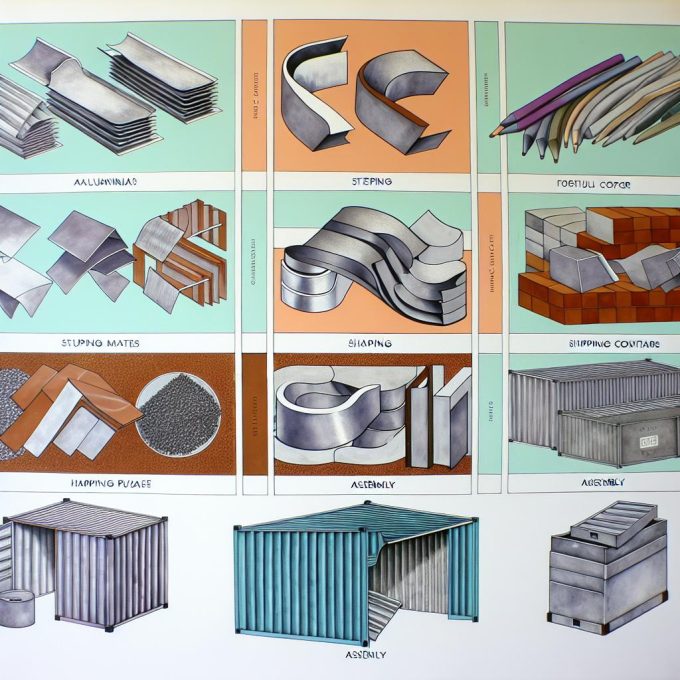Introduction to Container Manufacturing Materials
Containers play a crucial role in the modern logistics chain, facilitating the seamless transport of a multitude of goods across diverse regions and terrains. The materials utilized in container manufacturing are vital, not only in terms of determining the strength and longevity but also in ensuring cost-effectiveness and suitability for specific environments and goods. This article delves into the essential materials used in container manufacturing, examining the advantages and challenges associated with each.
Steel: The Backbone of Container Construction
Steel stands as the fundamental material in the realm of container manufacturing. Its unrivaled strength and resilience against harsh environmental factors make it the preferred choice, especially for ISO shipping containers. These containers predominantly traverse across oceans, rail networks, and roads, making durability a crucial factor.
One of the critical types of steel employed in this process is corrosion-resistant Corten steel. Designed to endure the rigors of extreme weather conditions, Corten steel provides a distinct advantage by developing a stable, rust-like appearance. This protective layer averts further corrosion, thereby enhancing the lifespan of the container. For those interested in exploring Corten steel in depth, further information can be found at dedicated manufacturing sites.
Pros and Cons of Steel
The chief merit of steel as a container material lies in its robust strength, ensuring containers maintain structural integrity and security, even under substantial load stress. Nevertheless, steel’s drawbacks include its considerable weight and its necessity for routine maintenance to stave off corrosion, especially when not inherently resistant like Corten steel. Additionally, the weight of steel containers may contribute to elevated transportation costs.
Aluminum: A Lightweight Alternative
In contrast to steel, aluminum presents a compelling option in container manufacturing due to its lightweight properties. This characteristic significantly reduces transportation costs, making it a favored option for air cargo and specific land transport scenarios. Furthermore, aluminum’s natural resistance to corrosion reduces maintenance frequency and costs.
Although the manufacturing process for aluminum containers can be costly, their lighter weight offers immense value, particularly in situations where reducing weight is imperative, such as air transport. Interested readers can explore further details about aluminum at dedicated resources online.
Pros and Cons of Aluminum
Aluminum’s primary benefit is its lightweight nature paired with strong corrosion resistance, which appeals to logistics processes that prioritize weight efficiency and reduced maintenance. However, aluminum lacks the strength of steel and may be more susceptible to physical damage, such as dents, which can influence its performance in handling bulky or heavy items.
Composite Materials: Innovations in Container Design
In the search for enhanced container materials, composite materials emerge as a powerful contender. These composites fuse fiber-reinforced plastics with other components such as resin, providing a structure that excels in both strength and environmental resilience.
The ability to customize composite materials presents a significant advantage, allowing them to be engineered for specific properties like superior thermal insulation or heightened impact resilience. This makes them particularly apt for specialized applications that require tailored solutions. Interested individuals can explore more about these innovative materials on resources dedicated to composite technology.
Pros and Cons of Composite Materials
Composite materials shine through their ability to offer customized performance attributes, alongside impressive weather and corrosion resilience. However, the production of composites can involve complex processes and incur higher costs. Additionally, the overall strength may not reach the levels provided by traditional metals like steel.
Conclusion
Selecting the appropriate material for container manufacturing is a decision heavily influenced by the specific transportation scenario’s demands, encompassing considerations such as weight, environmental exposure, and cargo type. Every material—be it steel, aluminum, or composite—presents unique benefits and challenges. As the logistics sector progresses, innovations in materials and associated technologies strive to enhance efficiency while seeking to curb both costs and environmental impacts.
Considerations for Future Materials
As sustainability becomes an increasingly vital aspect of logistics, the materials used in container manufacturing will likely continue to evolve. Innovations in technology and materials science are paving new pathways for developing greener alternatives with reduced ecological footprints. Biodegradable materials, recycled composites, and advanced alloys are just a few examples of potential advancements the industry may witness.
Focusing on environmental sustainability alongside performance enhancements will drive the development of future materials. Collaborations between manufacturers, scientists, and environmental agencies will be crucial in finding solutions that meet both logistical and ecological needs.
Final Thoughts
Understanding the benefits and drawbacks of each material option is essential for businesses involved in logistics and fleet management. Not only does it inform decisions regarding the maintenance and durability of containers, but it also influences cost factors, which directly affect bottom lines. By continuing to invest in research and innovation, the logistics industry can look forward to materials that not only meet the functional demands of modern transportation but also align with the broader sustainability goals and environmental responsibilities of today’s world.
The ongoing exploration of materials science and engineering will undeniably shape the future of container manufacturing, offering solutions that are more efficient, durable, and environmentally friendly than ever before.

